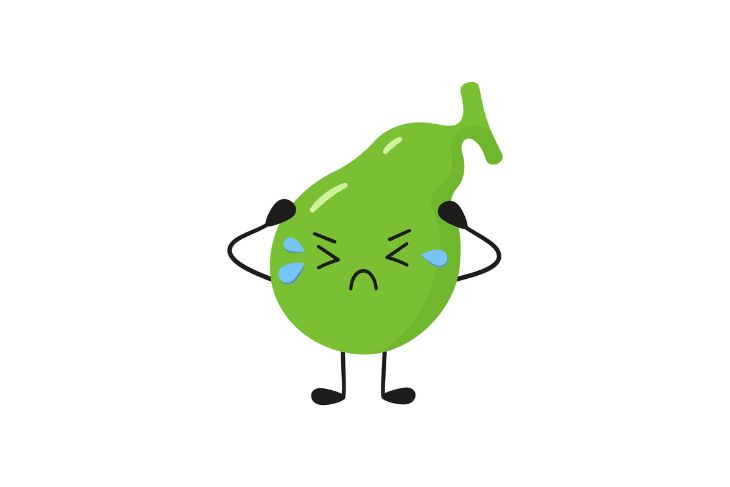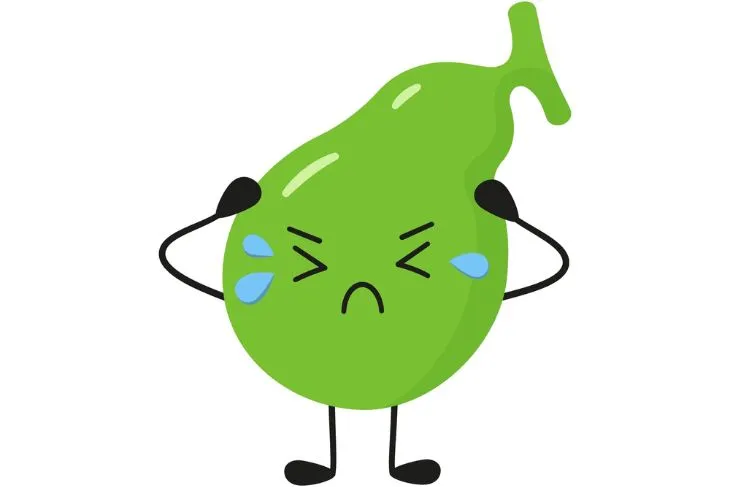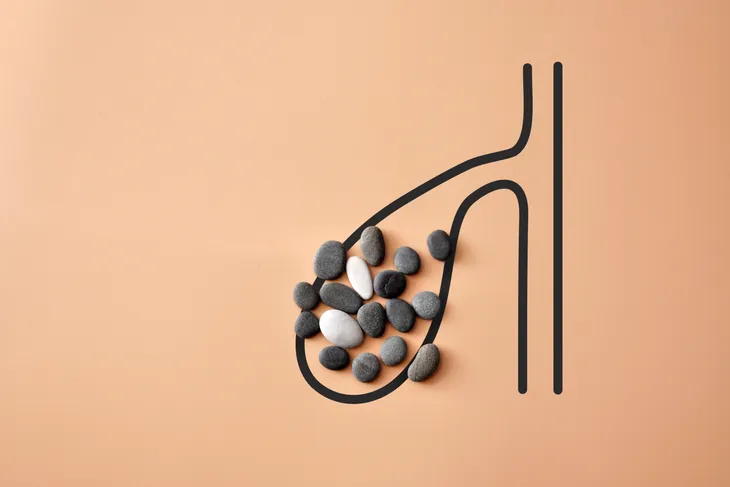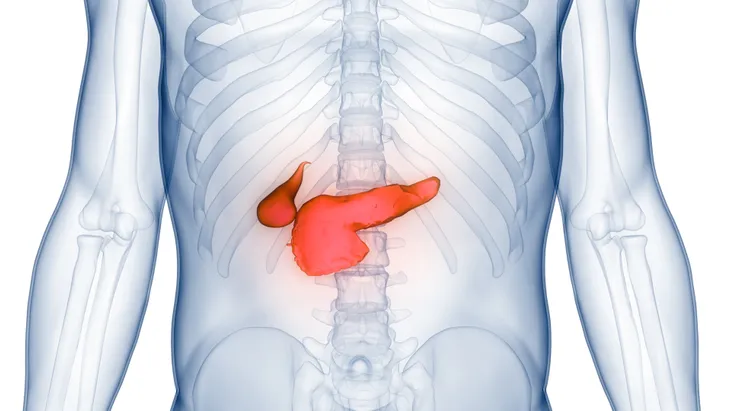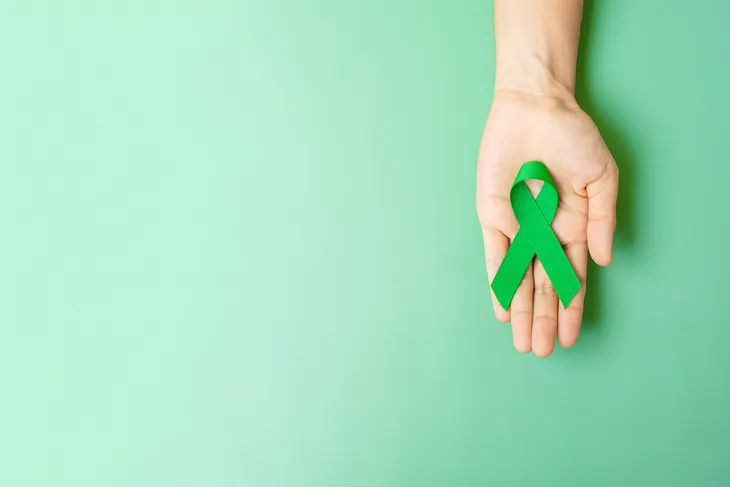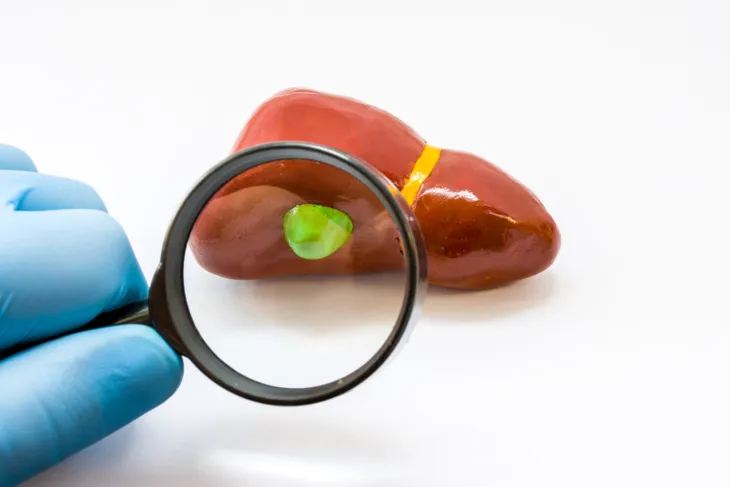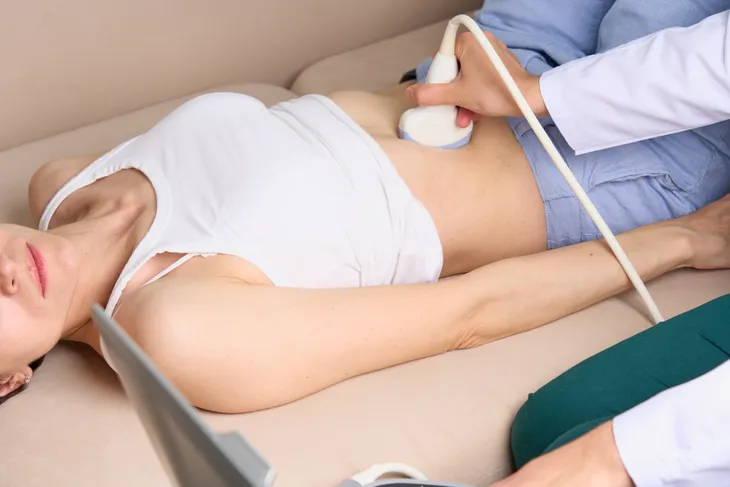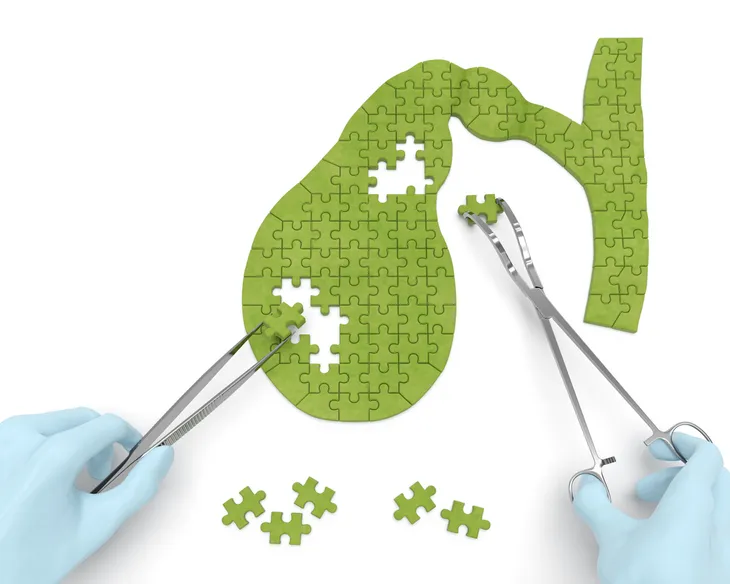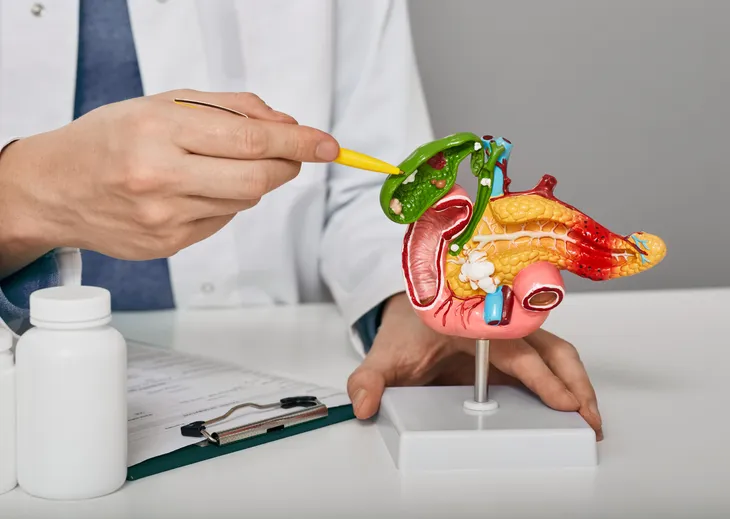- The gallbladder is responsible for storing bile and delivering it to the small intestine so that vitamins and nutrients can be absorbed into the bloodstream.
- Most common symptoms of gallbladder disease are abdominal pain (right side), fever, jaundice, nausea, and vomiting.
- There are several types of gallbladder disease including, gallstones, cholecystitis, biliary dyskinesia, gallbladder cancer, cholangitis, and cholangiopathy.
- Gallbladder disease can have serious complications. Treatment will depend on the type of disease, but could result in gallbladder removal surgery.
Located just underneath the liver, this small pear-shaped sac is responsible for storing bile. Bile is a combination of fluids, fat, and cholesterol necessary to break down the fat from food in our intestine. The gallbladder delivers bile to the small intestine, allowing fat-soluble vitamins and nutrients to be absorbed into the bloodstream, writes Healthline.
While the gallbladder is small and mostly unnoticeable, its job is important. When something goes wrong it can wreak havoc on our body. To learn more about gallbladder disease, read up on the types of gallbladder diseases, as well as the symptoms, causes, and potential treatment options.
What is Gallbladder Disease?
Just like any organ in the human body, things can go wrong with the gallbladder. Gallbladder disease is a term used for several types of conditions, including inflammation, infection, stones, or blockage of the gallbladder. The gallbladder plays an important role in our digestive system. It stores the bile our liver makes and then sends it to the small intestine to help break down food, according to the Cleveland Clinic. The bile travels through a series of pipes known as bile ducts.
The source goes on to explain that gallbladder disease can occur in the gallbladder or the bile ducts connected to it. If an infection or blockage occurs in these ducts, it can back up the entire gallbladder. It can also cause problems in other organs of the digestive system since the bile ducts are connected to them as well.
Symptoms of Gallbladder Disease
While there are many different types of gallbladder disease (we’ll get into each specific one later on in the article), there are some overarching symptoms. The most well recognized and universal sign of gallbladder disease is pain in the upper right quadrant of the abdomen (where the gallbladder is located), explains VeryWell Health.
Any other symptoms associated with gallbladder disease will depend on the specific type. Other common symptoms include fever, jaundice, nausea, vomiting, and pruritis. VeryWell Health advises anyone who experiences these symptoms to contact their healthcare provider right away. If you notice signs of jaundice, get immediate help.
Types of Gallbladder Disease
Gallstones
The most common form of gallbladder disease is gallstones. These occur “when substances in the bile (such as cholesterol, bile salts, and calcium), or substances from the blood (like bilirubin) form hard particles that block the passageways” between the gallbladder and bile ducts, writes Healthline. They can range in size from either being as small as a grain of seed to as large as a golf ball.
Biliary colic is often the first symptom of gallstones. It may begin as a dull ache that occurs with contractions after a meal. The Cleveland Clinic says most people report feeling it in the upper right side of their abdomen, under the right rib cage. It can also radiate into their side and up into the shoulder blade. You might also experience nausea and vomiting.
Cholecystitis
Another common type of gallbladder disease is cholecystitis. It can present as either acute or chronic cholecystitis, says Healthline. If acute, it’s usually caused by gallstones, but can also occur from tumors or other illnesses. Symptoms of acute cholecystitis are pain (usually after a meal) in the upper right side of upper middle area of the abdomen. This pain ranges from being sharp pangs to dull aches, notes the source. You might also experience fever, nausea, vomiting, and jaundice.
Chronic cholecystitis is a result of long-term inflammation from acute cholecystitis. When this occurs the gallbladder shrinks in size, affecting its ability to store and release bile. You’ll experience abdominal pain, vomiting, and nausea, says Healthline, and require surgery. Both forms of cholecystitis can have serious complications and require immediate medical attention.
Biliary Dyskinesia
Biliary dyskinesia is a motility problem in the gallbladder, known as a functional gallbladder disorder. Essentially, the gallbladder isn’t moving bile out into the bile ducts as it should be. This condition is often related to gallbladder inflammation, says Healthline. While it often has the same effects as a gallstone or other obstruction, there are usually no gallstones in the bladder with biliary dyskinesia. The Cleveland Clinic explains that it’s more of a mechanical issue involving muscles and nerves.
The most common symptoms associated with this condition are abdominal pain (especially after eating), bloating, nausea, and indigestion. You might notice that fatty foods trigger these symptoms. A HIDA scan is necessary to make a diagnosis. This test measures gallbladder function. According to Healthline, if a gallbladder is only releasing 35 to 40-percent of its contents or less, then it will likely result in a biliary dyskinesia diagnosis.
Gallbladder Cancer
Gallbladder cancer is classified as the abnormal growth of cells that begins in the gallbladder, says the Mayo Clinic. This type of gallbladder disease is very rare. If detected in the early stages, the chances of recovery are quite high. Unfortunately, because there are often no signs or symptoms, most cases are discovered at a late stage when the prognosis is poor.
The Mayo Clinic lists the following as the most common symptoms of gallbladder cancer: abdominal pain (upper right portion), unexplained weight loss, abdominal bloating, and jaundice of skin and eyes.
Cholangiopathy and Cholangitis
This is essentially any disease of the bile ducts, which includes cholangitis. In fact, the Cleveland Clinic says cholangiopathy usually begins with cholangitis which is inflammation of the bile ducts. It likely all started with a temporary infection, blockage, or progressive autoimmune disorder, such as primary biliary cholangitis, explains the source.
If the condition goes untreated, it can lead to scarring and narrowing of the bile ducts, leading to a back up of bile into the gallbladder and liver. According to Healthline, scarring from long term inflammation of the bile duct system is called sclerosing cholangitis. Nearly half of people with this condition don’t know it because it doesn’t present any symptoms. If there are symptoms, they will likely include fever, jaundice, itching, and upper abdominal discomfort. Healthline also notes that the exact cause is unknown.
Causes and Risk Factors
Gallstones are usually caused by too much cholesterol or bilirubin (a pigment made in the liver), says VeryWell Health. Some of the most common risk factors for gallstones are being female, over the age of 40, pregnancy, obesity, a diet high in cholesterol, refined carbohydrates, and saturated fats. Other factors include a sedentary lifestyle, rapid weight loss, medications that contain estrogen, and underlying diseases (ex. Crohn’s, diabetes, and cirrhosis).
In the case of biliary dyskinesia, health experts are still unsure what causes this type of gallbladder disease. Functional gallbladder disorder is when people have biliary pain, but without gallstones. Again, “while still unclear, it’s possible that people with an underlying gastrointestinal motility issues (for example gastric emptying) may be at risk for developing functional gallbladder disorder,” writes VeryWell Health.
Lastly, gallbladder cancer is actually quite rare and is a result of rapid and uncontrollable cell growth. VeryWell Health points out that the biggest risk factor is again, people who’ve had gallstones. Other risk factors include being female, older age, obesity, ethnicity (Mexican American or Native American), chronic infection with Salmonella Typhi bacteria, cysts within the bile duct, gallbladder polyps, and abnormalities of bile ducts.
Diagnosing Gallbladder Disease
If you think you’re experiencing symptoms of gallbladder disease, seek medical attention. Your healthcare provider will be able to assess and provide a proper diagnosis, and hopefully treatment. To start, they will look at medical history and symptoms. They will pay close attention to your vital signs, including heart rate, blood pressure, and body temperature to assess for fever, notes the Cleveland Clinic.
The next steps would be a physical examination, particularly looking for any jaundice or swelling in the abdomen. “They might feel the abdominal area where your gallbladder is located,” writes the source. “If they can feel your gallbladder, that’s a sign of inflammation.” They will follow this up with blood tests (blood count, liver function tests, pancreas function tests) and imaging tests (HIDA scan, abdominal ultrasound, endoscopic retrograde cholangiopancreatography, and endoscopic ultrasound).
Treatment of Gallbladder Disease
Treatment depends on the type of gallbladder disease. For gallstones, the most common type of gallbladder disease, if there are no symptoms (often there aren’t), a doctor will essentially “watch and wait.” The other option is a procedure to remove the gallbladder or destroy the stones, says VeryWell Health. They could also try using medication to break up the gallstones or antibiotics to fight an infection. Other types of gallbladder disease that are more complex, such as a stone that is stuck in a bile duct, will likely require a more specialized procedure (ERCP).
According to the same source, oftentimes the primary treatment for most gallbladder diseases is to surgically remove the gallbladder, also known as a cholecystectomy. This is the only permanent and effective solution for persistent gallbladder disease. Most people can live without their gallbladder and have it removed laparoscopically which is minimally invasive. In more severe cases of gallbladder disease, an open cholecystectomy or extended cholecystectomy may be necessary.
Potential Complications of Gallbladder Disease
All gallbladder diseases require medical attention as they can lead to serious complications. Acute cholangitis can develop from a bacterial infection in the biliary tract which is associated with biliary obstruction. You’ll experience fever, upper right-sided abdominal pain, possibly jaundice, low blood pressure, and confusion, warns VeryWell Health.
Another potential complication is pancreatitis. This is an inflammation of the pancreas and often a complication of gallstones. “This is because the gallbladder and pancreas share a bile drainage duct, so an obstructing gallstone can prevent the flow of pancreatic enzymes,” writes the source. You could also develop liver cirrhosis if the bile backs up into the liver. This will do long term damage to the livers functioning and create complications in other organs, says the Cleveland Clinic.
Delayed treatment of gallbladder attacks can lead to gangrenous cholecystitis, which is a common complication of cholecystitis. This is a very serious complication that requires an immediate removal of the gallbladder. Another life-threatening complication is gallbladder perforation. This occurs when the gallbladder becomes gangrenous, “a perforation (a hole in the wall of the gallbladder) may develop, resulting in a pericholecystic abscess (a collection of pus in the gallbladder),” writes VeryWell Health. It also requires an emergency cholecystectomy.
Prevention of Gallbladder Disease
Unfortunately, certain risk factors such as gender and age cannot be avoided. However, there are things people can do to limit their chances of developing gallstones which is one of the most common forms of gallbladder disease. Diet plays a large role in developing gallstones. The National Institute of Diabetes and Digestive and Kidney Diseases (NIDDK) suggests we eat foods that are high in fiber and healthy fats to prevent gallstones.
Healthline also points out that eating too many refined grains (sugary cereals, white rice, bread, and pasta) and sugary sweets can also increase a person’s risk of gallbladder disease. Try replacing these foods with more whole grains like brown rice and whole wheat bread. You should also try to implement healthy fats from fish and olive oil.
Another great form of prevention is to be in tune with your body! The sooner gallbladder problems are detected and treated, the less likely it is that any complications will occur. Talk to your doctor if you suspect you’re experiencing any symptoms of gallbladder disease.
